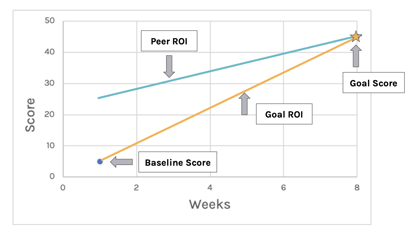Approaching data conversations with the right mindset can make all the difference in the outcome and the effectiveness of the meeting. Skillful data conversations can be a challenging practice for any educator—it is essential to approach these discussions with positive intent and a focus on problem-solving.
In the Webinar “The MTSS 6-Week Intervention Check-In,” Brittany Shurley and Larissa Napolitan discuss utilizing a problem-solving framework for examining data after six weeks of intervention. This framework could apply to any data discussion throughout the school year.
| Want to skip ahead to the webinar recording? WATCH THE WEBINAR |
Data-Based Decision Making
One of the key components of the Multi-Tiered System of Supports framework is utilizing data as a tool for decisions and problem-solving to support students. Data frames the discussion of what is working and what isn’t. Data makes diagnosing problems more efficient, selecting strategies clearer, and can help plan and refine the curriculum. Using data as part of a problem-solving protocol creates a culture of continuous improvement.
At the 6-Week Check-in, it is vital to monitor and measure data to determine if the intervention is working - and if not, determine the root cause. Look closely at the ROI (Rate of Improvement), the needed slope line to move from the current baseline to the goal score.

4 Steps for Data-Based Decision-Making and Problem-Solving

1. Root Cause Analysis
At the 6-week mark after implementing interventions, there will be trends and patterns to address. When analyzing the data from a specific time frame, it is good practice to identify where the root cause of problems exists. Ask questions about the data. Does the intervention have the effect that you want it to have?
2. Creating and Evaluating Plans
At the 6-Week Check-In, it’s time to evaluate the plan using the progressing monitoring data with norming charts.
|
Questions for Evaluating Plans:
|
3. Implement and Monitor Progress
With any plan, monitoring the data as the plan progresses is critical. Suppose in week 2 or 3 it appears that the intervention is ineffective. In that case, it’s time to check on the fidelity of the intervention:
- Quality of engagement or delivery
- Adherence to time or minutes of intervention
- Time of day
- Student attendance or different levels of intervention
4. Changing or Adapting Goals/Plans
After monitoring that progress, determine if there is sufficient growth and make changes. This is when you set the next steps for the students and go back to the beginning of the problem-solving cycle. While these decision rules provide a framework for how to change, escalate, etc., interventions, it is essential to remember that data-driven decisions are made by teams and are collaborative in nature. It’s good practice to consider several possibilities for root causes before jumping to changing support levels, programs, and cadence of program delivery.
📊 Check out this worksheet: Questions for MTSS Data Analysis Worksheet
Collecting Data is Not Enough
MTSS is not just about collecting data but also about using the data to continually improve our practice and ensure students have the most effective support. School leaders should use data to look for school or grade-level trends. Normed screener and progress monitoring data can assist leaders in continuing to provide a system of supports and professional development to teachers and staff around key areas of improvement.
WATCH THE WEBINAR
(And get ready to take notes ✍️)
Related resources you may find helpful:
|
How To Use Progress Monitoring To Guide Decision-Making in MTSS |
|
|
Best Practices of Data Analysis and Differentiation for Tier 1 in MTSS |
Check out our WEBINAR SERIES:

About the author
Larissa Napolitan
Larissa Napolitan is the Content Marketing Manager at Branching Minds and host of the Schoolin’ Around podcast, where she spotlights innovative voices and practices shaping education today. A former middle school teacher and instructional coach, Larissa draws on her classroom experience to create meaningful content that connects research, storytelling, and practical insights for school and district leaders. She is passionate about amplifying educator voices and supporting the growth of all students.

Your MTSS Transformation Starts Here
Enhance your MTSS process. Book a Branching Minds demo today.


















.png?width=716&height=522&name=MTSS-interventions-secondary-school(preview).png)
